Did you know the average American household wastes up to 30% of their water? That’s nearly 100 gallons daily going straight down the drain! Transform your homewith-a-friendly oasis by Simplifying Water Recycling with Greywater Systems. Learn how to conserve water and reduce bills for your family,
Welcome to your comprehensive guide on transforming ordinary homes into water-efficient spaces. Greywater refers to the gently used water from your sinks, showers, and washing machines that can be recycled rather than wasted. These practical solutions capture this valuable resource and redirect it to your garden, toilet, or other non-potable uses.
At Sustainable Home Magazine, we believe eco-friendly plumbing options should be accessible to everyone. Our team has researched the most effective water recycling methods that don’t require engineering degrees to implement or maintain.
By adopting these practices, you’ll enjoy lower utility bills while significantly reducing your environmental footprint. The satisfaction of knowing your daily routines contribute to conservation efforts brings an unexpected bonus – peace of mind in your sustainable living journey.
This guide breaks down complex wastewater management concepts into practical steps anyone can follow. Whether you’re a seasoned environmentalist or just beginning to explore greener options, you’ll find valuable insights in the pages ahead.
Table of Contents
Key Takeaways
- Greywater systems can reduce household water consumption by up to 30%
- Implementation ranges from simple DIY solutions to comprehensive professional installations
- Most systems pay for themselves within 2-3 years through reduced water bills
- Properly designed systems require minimal maintenance
- Local regulations vary, so checking permit requirements is essential before installation
- Water recycling contributes significantly to conservation efforts during drought conditions
Understanding Greywater Basics for Water Recycling.
Starting to use greywater is a big step towards saving water. By installing a greywater system, you can cut down on water waste. This not only helps the environment but also makes your home more self-sufficient.
What Qualifies as Greywater in Your Home
Greywater is water that’s been used lightly in your home. Not all wastewater is greywater. Knowing the difference is key for using water wisely.
Here are some common sources of greywater:
- Shower and bathtub water
- Bathroom sink water
- Washing machine water (from rinse cycles)
- Air conditioner condensate
But, not all water is safe for reuse. Here are examples of water that’s not greywater:
- Toilet water (blackwater)
- Kitchen sink water (contains food particles and grease)
- Dishwasher water (high sodium content)
- Water used to wash diapers or soiled items
According to Sustainable Home Magazine, a typical household can reuse 30-40 gallons of greywater daily. This is a lot of water that could be saved from going down the drain.
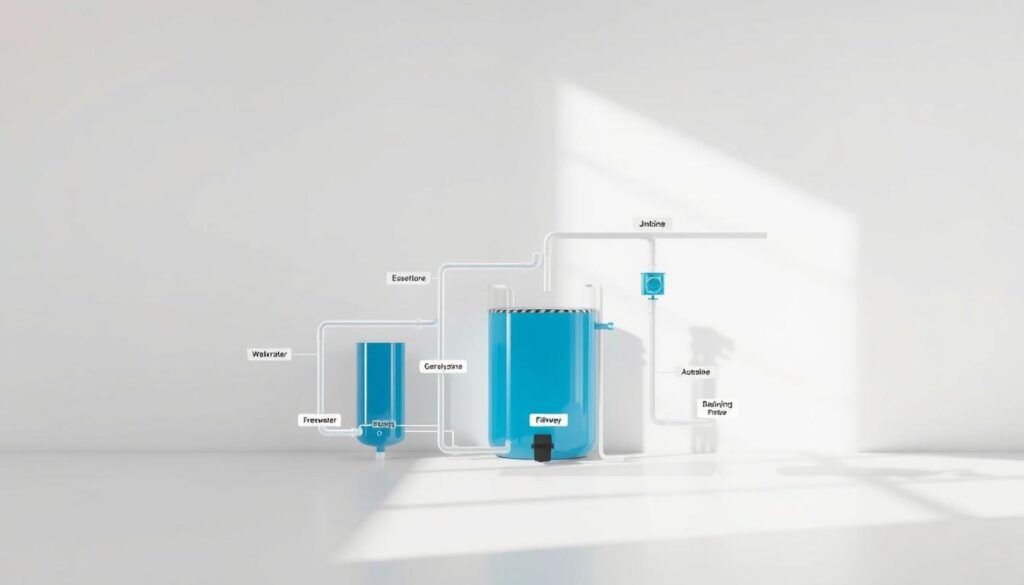
Benefits of Greywater Recycling for Your Household
Using greywater has many benefits. It saves water and helps the environment. It also saves money and makes your home more efficient.
Environmental Benefits:
- Reduces freshwater use by up to 30%
- Less wastewater for treatment facilities
- Lessens your home’s environmental impact
- Uses less energy for pumping and treatment
Household Benefits:
- Lower water bills
- Longer life for septic systems
- More drought-resistant property
- Nutrient-rich water for plants
Many homeowners save 15-30% on water bills with greywater systems. This makes the cost of installing a system worth it for most families.
Common Misconceptions About Greywater Safety
Some people think greywater systems are unsafe or hard to install. But, the truth is different.
Misconception #1: Greywater is dirty and unsafe
Reality: Greywater is safe for irrigation when treated right. Modern systems keep harmful bacteria out.
Misconception #2: Greywater systems are complicated to install
Reality: Simple systems can be set up by homeowners with basic plumbing skills. More complex ones might need a pro, but they’re still doable.
Misconception #3: Greywater smells bad
Reality: Good systems use greywater fast or within 24 hours. This stops smells. The key is to avoid storing it.
Misconception #4: Greywater harms plants
Reality: Greywater is good for plants if you use plant-friendly soaps. It has nutrients that help plants grow.
Calculating Your Potential Water Savings
Knowing how much water you can save with a greywater system helps justify the cost. You can estimate your savings with a few simple steps.
To figure out your greywater production:
- Track shower and bath water (25-40 gallons per shower)
- Watch washing machine water (15-45 gallons per load)
- Measure bathroom sink water (1 gallon per minute)
- Multiply by how often you use it
For example, a family of four might save:
- Showers: 4 people × 30 gallons × 7 days = 840 gallons weekly
- Laundry: 5 loads × 35 gallons = 175 gallons weekly
- Bathroom sinks: 4 people × 5 gallons daily × 7 days = 140 gallons weekly
This adds up to about 1,155 gallons of greywater weekly. That’s nearly 60,000 gallons a year. At $0.005 per gallon, that’s $300 saved annually. Plus, it makes your water use more efficient.
When thinking about greywater systems, remember even small steps can help a lot. There are simple DIY projects and more complex setups. You can find one that fits your home and needs.
Laundry-to-Landscape System
The laundry-to-landscape system is a simple and effective DIY solution. It uses the water from your washing machine to water your garden. You don’t need to change your home’s plumbing much. This project is easy to do in a weekend, making it a great start to living more sustainably.
This system is easy because washing machines already pump out water. This water can be sent to your yard without extra pumps. Let’s look at how to set it up step by step.
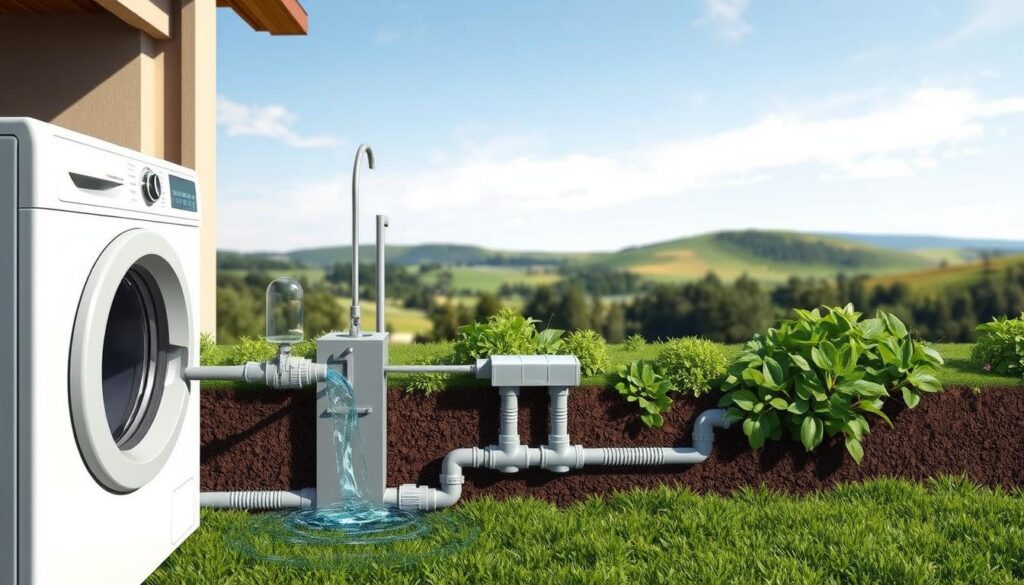
Materials List and Budget Breakdown
Before starting your DIY greywater system project, get all the materials you need. You can find everything at plumbing stores and home improvement centers.
Here’s a list of what you need, along with estimated costs. This will help you plan your budget:
| Component | Purpose | Estimated Cost | Where to Purchase | Notes |
|---|---|---|---|---|
| 3-way diverter valve (1″ or 1.5″) | Directs water to sewer or garden | $25-45 | Plumbing supply stores | Brass lasts longer than plastic |
| 1″ polyethylene tubing (50-100 ft) | Main distribution line | $20-40 | Irrigation supply stores | UV-resistant for outdoor use |
| 1″ barbed fittings (assorted) | Connect tubing sections | $15-25 | Hardware stores | Get tees, elbows, and couplings |
| Hose clamps (10-20) | Secure connections | $10-20 | Hardware stores | Stainless steel recommended |
| Mulch (2-3 cubic yards) | Creates filtration basins | $60-90 | Garden centers | Coarse wood chips work best |
The total cost is usually between $130-220. This depends on your yard’s size and the materials you choose. It’s cheaper than commercial systems, which can cost $500-1,000.
You’ll need a drill, pipe cutter, shovel, and basic tools. Most homeowners already have these. If you need to buy tools, add $75-100 to your budget.
Washing Machine Compatibility Assessment
Not all washing machines work well with graywater harvesting systems. Check your machine’s compatibility before buying materials.
Top-loading washing machines are best for this system. They have strong pumps that can send water up to 50 feet horizontally and 2-3 feet vertically. The drain hose is usually at the back, making it easy to access.
Front-loading machines are harder to use. They have weaker pumps that can’t send water as far. If you have a front-loader, you might need to place your system downhill from the machine or limit it to 20-30 feet horizontally with little elevation gain.
To test your machine’s pumping capacity:
- Run your washing machine on a normal cycle
- During the drain cycle, direct the drain hose into a bucket positioned at various heights
- Note the maximum height at which water still flows strongly
- Subtract 1 foot from this measurement for your system’s design
Also, check if your washing machine has a lint filter. If not, consider adding an external filter to prevent clogging in the distribution lines.
Diverter Valve Installation Steps
The diverter valve is key to your sustainable plumbing system. It lets you switch between sending water to your garden or the sewer. This is important during rainy seasons or when using bleach or other harmful products for gardening.
Follow these steps for a proper installation:
- Locate your washing machine’s drain pipe where it connects to the standpipe or utility sink
- Turn off the water supply to your washing machine
- Place a bucket under the connection point to catch any water
- Disconnect the drain hose from the standpipe
- Install the 3-way diverter valve at this junction, securing it to a nearby wall
- Connect one port to your existing sewer drain
- Connect another port to your new irrigation line
- Secure all connections with hose clamps
- Label the valve positions clearly (SEWER and GARDEN)
Mount the valve at least 6 inches higher than your washing machine’s drum. This prevents backflow issues and ensures proper drainage in both directions. If space is tight, consider relocating your washing machine slightly to accommodate the valve configuration.
Safety tip: Always check local building codes before installation. Some jurisdictions require anti-siphon devices or backflow preventers when modifying plumbing connected to municipal water systems.
Mulch Basin Construction for Optimal Filtration
Mulch basins are key for effective eco-friendly installations. They filter greywater and distribute it to plant roots. These basins prevent pooling, reduce evaporation, and eliminate odors.
To build effective mulch basins:
- Identify suitable locations near plants that will benefit from extra water (fruit trees, shrubs, and perennials work best)
- Dig shallow basins 12-24 inches wide and 6-8 inches deep around each plant
- Route your distribution tubing to each basin location
- At each basin, install a “T” or elbow fitting with the outlet pointing upward
- Cut a small piece (4-6 inches) of tubing to create a vertical outlet
- Fill the basin with coarse wood chip mulch, covering the outlet by at least 2 inches
The best mulch for greywater systems is coarse, untreated wood chips about 1-2 inches in size. Avoid fine mulches like bark dust or sawdust that can clog quickly. Cedar and redwood mulches resist decomposition better than softer woods, extending the life of your basins.
For optimal distribution, create one basin for every 10-15 gallons of washing machine discharge. A typical full load generates 30-40 gallons, so plan for 3-4 basins to handle the volume effectively.
Remember, residential plumbing modifications must follow local regulations. Sustainable Home Magazine suggests checking with your local building department before installation. They can tell you if your system meets all requirements. Some areas have specific rules about setbacks from property lines, depth of irrigation lines, and acceptable greywater uses.
With your laundry-to-landscape system complete, you’ll start saving water and nourishing your garden right away. This simple yet effective approach to water conservation is a big step toward sustainable living. It can be done with basic tools and materials in just one weekend.
Bathroom Sink Diversion System
Installing a bathroom sink diversion system is easy for homeowners of all skill levels. Unlike laundry systems, bathroom sinks produce smaller, consistent flows. These are perfect for indoor plants or small garden areas. Sustainable Home Magazine says these systems can save up to 1,825 gallons of water a year.
This system is one of the most cost-effective residential greywater systems. It often costs less than $100 and takes just a few hours to set up. Always check your local greywater regulations before starting to make sure you follow the rules.
Under-Sink Plumbing Modifications
Redirecting water from your bathroom sink is simple. These changes are non-permanent and can be reversed if needed. This makes them apartment-friendly in many cases.
To start, you’ll need some basic tools:
- Adjustable wrench
- Channel-lock pliers
- Teflon tape
- Bucket (to catch water during installation)
- Diverter valve or Y-splitter
- Flexible tubing (food-grade)
When working with plumbing, safety is key. Always turn off the water supply first. Place a bucket under the pipes to catch any water. If you’re not comfortable with plumbing, consider hiring a professional.
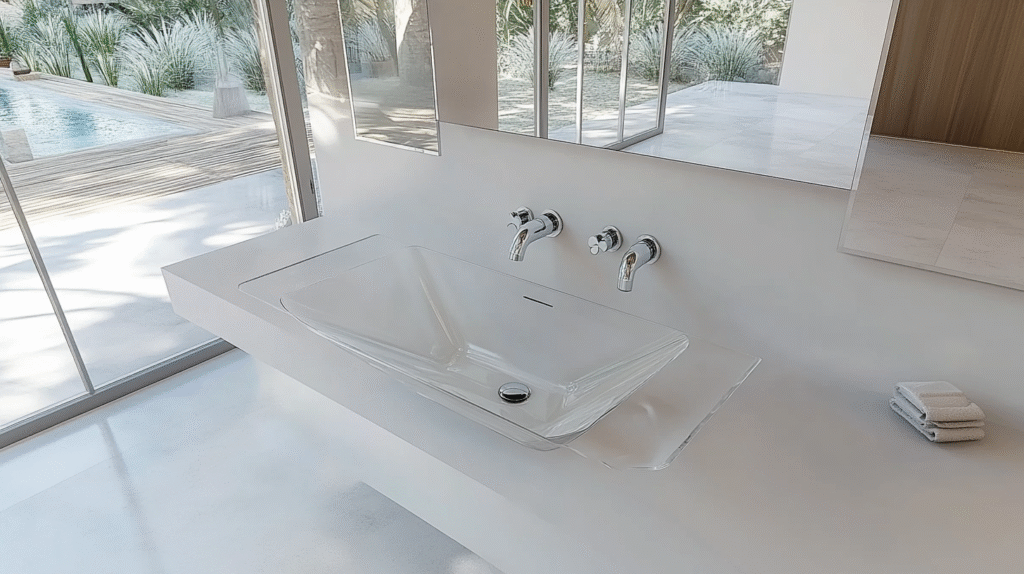
- Turn off the water supply to the sink and open the faucet to drain remaining water.
- Place a bucket under the P-trap to catch any water when you disconnect pipes.
- Unscrew the P-trap from the drain pipe. This is where you’ll install your diverter.
- Install a Y-splitter or diverter valve between the sink drain and P-trap.
- Connect flexible tubing to the diverter’s outlet port.
- Route the tubing to your desired destination (planter, collection bucket, etc.).
- Secure all connections with Teflon tape to prevent leaks.
- Test the system by running water slowly and checking for leaks.
This setup lets you switch between regular drainage and greywater collection easily. You can divert only the right water while sending other water to the sewer.
Selecting Eco-Friendly Soaps for Greywater Use
What you put down your drain affects your recycled water system. Regular soaps and hand sanitizers can harm plants and soil. Switching to plant-friendly products is key when using a sink diversion system.
Ingredients to avoid in your bathroom products include:
- Sodium compounds (including sodium lauryl sulfate)
- Boron or borax (toxic to plants in high concentrations)
- Antibacterial agents (can disrupt soil microbiome)
- Bleach or chlorine products
- Artificial fragrances and colors
Look for products labeled as greywater-safe or biodegradable. Castile soaps like Dr. Bronner’s are great for hand washing. Brands like Oasis Biocompatible and ECOS offer water recycling-friendly options.
Even with plant-friendly soaps, rotate irrigation areas to avoid soap buildup. This keeps soil healthy and maximizes your eco-friendly irrigation system’s benefits.
Simple Filtration Options for Sink Water
Bathroom sink water often has hair, toothpaste residue, and small debris. A simple filtration system can prevent clogs and harm to plants. It also extends your setup’s life and improves water quality for your plants.
Filtration options range from DIY to commercial, each with different needs and effectiveness. Here’s a comparison:
| Filtration Method | Materials Cost | Maintenance Frequency | Effectiveness | Best For |
|---|---|---|---|---|
| Mesh Sink Strainer | $2-5 | Daily cleaning | Basic – catches large particles | Minimal budgets, simple systems |
| Sock Filter | $5-10 | Weekly replacement | Good – catches medium particles | DIY enthusiasts, moderate use |
| Gravel/Sand Filter | $15-30 | Monthly cleaning | Very good – biological filtration | Consistent water users, gardeners |
| Commercial Greywater Filter | $50-200 | Quarterly maintenance | Excellent – multi-stage filtration | Long-term installations, heavy use |
| Branched Drain with Mulch | $20-40 | Seasonal mulch replacement | Good – natural filtration | Outdoor applications, garden beds |
For most bathroom sink applications, a two-stage approach works well. Use a mesh strainer at the drain to catch hair and larger particles. Then, add a sock filter or small gravel filter before the water reaches plants. This combination provides adequate gray water treatment for most indoor applications.
Indoor Planter Connection Methods
One of the best things about bathroom sink diversion is watering indoor plants automatically. There are many creative ways to connect your sink to your plants, making your home water-efficient.
The simplest way is to direct the flexible tubing from your diverter valve into a nearby planter. But you can enhance this setup in several ways:
- Window box connections: Route tubing along baseboards to feed window planters, creating a visual display of your sustainability efforts.
- Living wall irrigation: Connect your sink to a vertical garden system for dramatic indoor greenery that thrives on your daily hand-washing routine.
- Self-watering planters: Direct greywater into the reservoir of self-watering containers for low-maintenance plant care.
- Under-sink herb garden: Utilize the cabinet space beneath your sink for a compact herb garden that benefits from immediate water access.
When designing your indoor connection system, remember to include these key elements:
- Overflow prevention – ensure excess water has somewhere to go
- Access points for cleaning and maintenance
- Proper drainage to prevent waterlogging
- Odor control through adequate plant selection and soil management
For apartment dwellers, portable systems offer flexibility without permanent changes. Consider a collection container under the sink that can be manually emptied onto plants. This approach complies with rental restrictions while still capturing valuable water.
“Bathroom sink diversion systems represent the perfect intersection of simplicity and impact. With minimal investment, homeowners can save thousands of gallons annually while creating thriving indoor gardens.”
By making these simple changes to your bathroom sink, you’re not just saving water. You’re also creating a visible, daily reminder of sustainability in action. The consistent flow from a sink makes it ideal for beginners in greywater recycling, providing immediate feedback and tangible results as your plants flourish with this reclaimed resource.
Shower Water Recycling System
Turning your shower into a water-saving machine is easier than you think. A well-designed greywater system can capture up to 30% of your home’s water. This means big savings on your water bills and a step towards a greener lifestyle.
Shower systems need more planning than simple greywater projects. But the water savings are worth it. Start with what you’re comfortable with, and gradually add more parts to your system.
Shower Drain Capture Methods
The first step is figuring out how to catch water from your drain. For beginners, simple solutions are a good start to greywater recycling.
A shower drain diverter is a simple fix. It fits over your drain and sends water to a hose. These cost $20-50 and don’t need permanent changes. For a more permanent setup, a three-way diverter valve lets you switch between sewer and greywater.
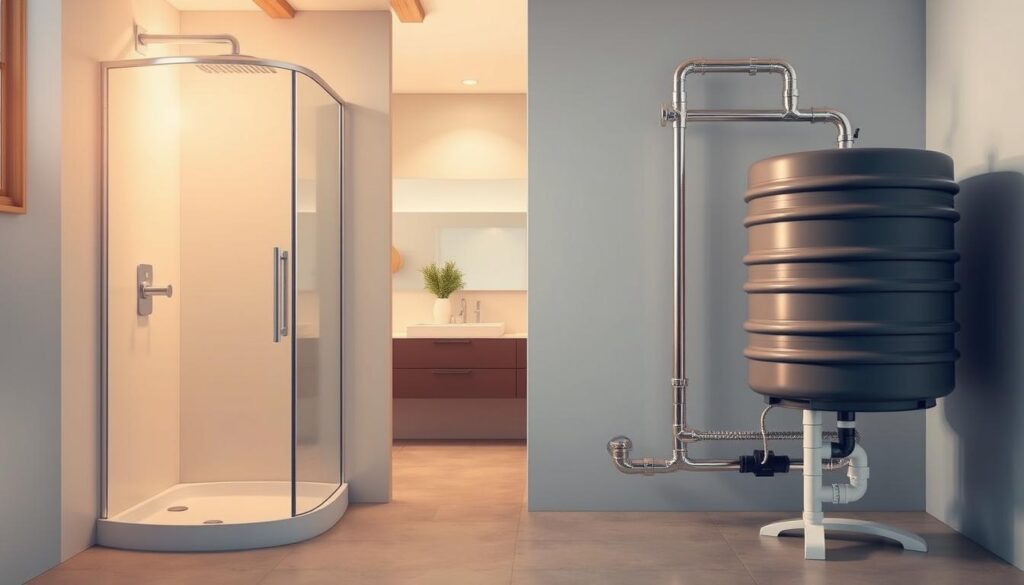
For a permanent fix, replace a drain pipe section with a diverter assembly. This is reliable but needs plumbing skills. If you’re not sure, get a plumber who knows greywater treatment.
Gravity-Fed Distribution Design
A good shower greywater system works without electricity. It uses gravity to move water to your garden.
Keep a 2% slope in pipes for gravity flow. Use 1½-inch pipes for main lines to avoid clogs. Important design tips include:
- Put your collection point higher than your garden
- Use smooth pipes like PVC or ABS
- Install cleanouts for easy maintenance
- Avoid uphill runs that need pumping
Plan your system before buying materials. Measure from your shower to your garden. This helps figure out pipe lengths and any obstacles.
Surge Tank Installation for Flow Management
Shower water bursts can flood your irrigation system. A surge tank holds water and releases it slowly. This prevents flooding and ensures even watering.
A basic surge tank is a 55-gallon barrel with some changes:
- Cut a hole near the top for your drain
- Add a filtered outlet for your distribution line
- Install an overflow pipe to the sewer
- Put in a removable lid for cleaning
Place your surge tank close to the shower for gravity flow. Elevate it on a platform if needed. This setup helps manage water flow and saves water.
“Shower-to-garden systems represent the sweet spot in home greywater recycling—offering maximum water volume with minimal treatment needs when properly designed.”
Outdoor Connection Through Existing Walls
Getting your greywater pipes through walls needs careful planning. This keeps your home safe and prevents water damage. Choose a method based on your wall type and shower location.
For wood-framed walls, find a stud spot with a stud finder. Then, drill a hole and check for wires or pipes. For masonry walls, use a rotary hammer drill with a masonry bit.
After making your hole, follow these steps for a professional finish:
- Insert a pipe sleeve slightly larger than your greywater pipe
- Apply waterproof flashing around the exterior opening
- Seal gaps with waterproof sealant
- Install a rodent guard on the exterior end if needed
For homes with crawl spaces or basements, pipes under the floor are easier. This reduces wall penetrations and simplifies your greywater system installation.
Local building codes might need permits for wall changes or plumbing work. Check with your building department before starting to ensure your green technology project follows rules.
By carefully setting up each part of your shower water recycling system, you’ll create a top-notch wastewater recycling solution. It saves water, cuts down on bills, and helps the environment. The effort is worth it for the long-term savings and the joy of using your shower water to feed your garden.
Integrated Multi-Source System
An integrated multi-source greywater system is the top choice for saving water at home. It uses water from different places like laundry, showers, and bathroom sinks. This water goes through a central system before being used in your garden.
These systems save a lot of water, up to 50% less than usual. They are more complex than single-source systems but offer bigger water-saving benefits.
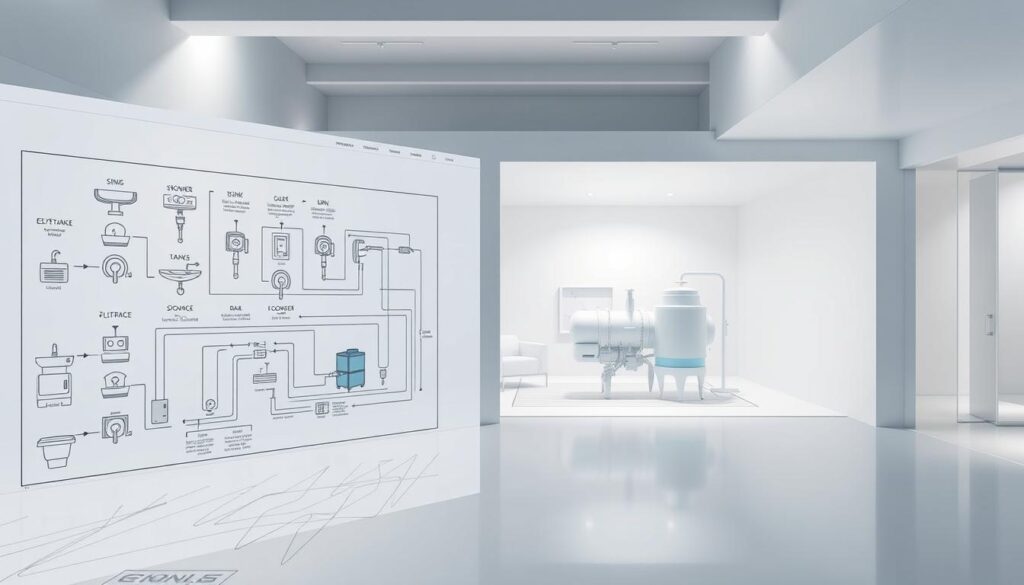
Prioritizing Water Sources by Quality and Volume
Not all greywater is the same. When setting up your system, look at the water’s quality, how much you get, and how easy it is to capture.
Shower water is the biggest source, up to 40 gallons a day for a family of four. It’s also pretty clean. Laundry water is also big but depends on your detergent. Bathroom sink water is less but easy to get with little plumbing changes.
Plan your system by starting with the biggest, easiest sources like laundry or showers. This way, you save water fast and build a complete system.
| Water Source | Daily Volume (gal) | Water Quality | Capture Difficulty | Implementation Priority |
|---|---|---|---|---|
| Shower | 25-40 | Good | Medium | High |
| Washing Machine | 15-30 | Variable | Low | High |
| Bathroom Sink | 5-10 | Good | Low | Medium |
| Bathtub | 30-50 (per use) | Good | Medium | Medium |
Central Collection Design Considerations
The heart of your system is the central collection point. It’s where all the greywater comes together. Designing this part well is key to a good system.
Choose a tank size based on how much greywater you make each day. A 50-100 gallon tank is usually enough. Put it in a low spot to use gravity flow, saving on pumps.
Use a two-stage filter system. First, a screen filter to catch big stuff like hair. Then, a finer filter for smaller particles. This keeps your system running smoothly.
- Put the tank where you can easily get to it for upkeep
- Have an overflow that goes to your sewer system
- Use clear ports to check water levels and quality
- Think about a small pump if your place is uphill
Good design is key to a system that lasts, says Sustainable Home Magazine. Well-designed systems need 60% less maintenance than bad ones over five years.
Creating a Distribution Manifold
The manifold is like the brain of your system. It decides where the greywater goes. It makes your system smart and efficient.
Make your manifold with 1-inch PVC pipe and valves for each zone. This lets you control where the water goes. For example, you can water fruit trees in summer and flowers in spring.
Put the manifold high enough to push water to your garden. Label the valves so you know which one does what. Use waterproof tags or colors to mark each zone.
“A well-designed manifold transforms greywater from a simple conservation method into a precision gardening tool, allowing homeowners to direct this valuable resource exactly where and when it’s needed most.”
Automated vs. Manual Switching Options
How you control your system is important. You can use simple valves or advanced systems with green technology.
Manual systems are easy and reliable. They cost less upfront but need you to switch them. They’re good for homes with steady water use.
Automated systems use sensors and electronic valves. They adjust water flow automatically. They cost more but save water and are convenient.
Many people choose a mix of both. Automate big sources like showers but use manual valves for less frequent ones like laundry. This balances cost and convenience.
When looking at greywater installation guides, choose a system that fits your skills. Start simple and add more as you learn.
Integrated systems are a big investment in your home. Start with the most important parts and add more as you can. This saves money and water right away.
Maintenance and Troubleshooting
Keeping your greywater system in good shape is key to its long-term success. These systems are designed to be easy to care for. Regular checks can prevent most problems before they start.
Sustainable Home Magazine says well-kept greywater systems need only 1-2 hours of care each month. This small effort can save a lot of water and keep your system reliable.
Monthly Maintenance Checklist for Greywater Systems
Having a regular maintenance routine is crucial for a trouble-free greywater system. Most tasks are simple and quick. By following this checklist each month, you’ll keep your system efficient and extend its life.
| Maintenance Task | Frequency | Tools Needed | Time Required |
|---|---|---|---|
| Inspect and clean filters | Weekly | Gloves, small brush | 5-10 minutes |
| Check distribution lines for clogs | Monthly | Flashlight, pipe snake | 15-20 minutes |
| Assess soil moisture levels | Bi-weekly | Soil moisture meter | 10 minutes |
| Monitor plant health | Monthly | None | 10 minutes |
| Check for leaks | Monthly | Flashlight | 15 minutes |
When checking filters, watch out for lint and hair buildup, more so in laundry-to-landscape systems. For systems with multiple sources, inspect each point separately. Always wear gloves when handling filters and clean them outside to avoid mess.
Clearing Clogged Distribution Lines
Even with regular filter care, distribution lines can get clogged. Catching clogs early makes them easier to fix. The first sign of a clog is usually uneven water distribution or reduced flow to certain garden areas.
For minor clogs, flushing the system with clean water often fixes the issue. Connect a garden hose to your cleanout access point and run water at moderate pressure. If this doesn’t work, a manual pipe snake can help with straight pipe sections.
For stubborn blockages, follow this step-by-step approach:
- Find the clogged section by checking which outlets have reduced flow
- Disconnect the affected line at the nearest junction
- Use a bottle brush or pipe cleaning tool to remove the blockage
- Flush with clean water until the flow is restored
- Reconnect the line and test the system
Prevention is always easier than clearing established clogs. If you often get blockages, consider adding more filters or strainers at key points.
Detecting and Repairing Leaks
Leaks waste water and can damage your property if not fixed. Common leak spots include connection points, valves, and areas where pipes may be stressed. Regular checks help catch small leaks before they become big problems.
Signs of a leak in your greywater system include:
- Unexplained wet spots in your yard
- Unusually lush or green patches of vegetation
- Decreased water pressure at distribution points
- Damp or water-stained areas near indoor components
- Musty odors around plumbing fixtures
When you find a leak, the repair depends on its location and severity. For simple connection leaks, tightening fittings or replacing gaskets often fixes it. For pipe cracks or breaks, you’ll need to replace the damaged section.
Keep repair materials handy, like pipe cement, spare pipe sections, and extra fittings. This way, you can fix leaks quickly, saving water and preventing damage to your eco-friendly plumbing.
Odor Prevention and Management
One common worry about greywater systems is odors. A well-designed and maintained system should not smell bad. Odors usually mean water is being stored rather than flowing through the system.
The key to preventing odors is to ensure water moves quickly through your system and into the soil. Greywater should never stay in pipes or collection vessels for more than 24 hours. This prevents the anaerobic conditions that cause sulfurous odors.
If you notice odors, try these solutions:
- Check for areas where water might be pooling and adjust your system to eliminate them
- Ensure adequate air gaps at all appropriate points in your system
- Add more mulch to basins to improve filtration and biological processing
- Consider switching to more biodegradable soaps and detergents
- Flush the system with clean water occasionally to prevent buildup
Biological additives are rarely necessary for properly designed greywater systems. But if odors persist, natural bacterial products designed for greywater treatment can help establish beneficial microbes that prevent odor-causing conditions.
Remember, your greywater system is part of a larger commitment to sustainable living. The minimal maintenance required pays dividends through water conservation and reduced utility bills. As you get to know your system, maintenance will become second nature—a small but meaningful part of your eco-friendly lifestyle.
We encourage you to share your experiences and questions through the Sustainable Home Magazine community. The collective wisdom of fellow greywater enthusiasts can provide valuable insights for troubleshooting and optimization. Your success stories also help inspire others to adopt water efficiency practices in their homes.
Greywater-Safe Garden Planning
Creating a garden that works with your greywater system is the next step in your water reuse journey. The right planning ensures your plants thrive. It also maximizes the benefits of your recycled water.
Soil Types That Thrive with Greywater Irrigation
Loamy soils with good drainage work best for eco-friendly irrigation using greywater. Clay-heavy soils may need sand or compost to prevent water pooling. Sandy soils benefit from organic matter to retain moisture and filter impurities.
Plant Selection for Greywater Tolerance
Choose plants that handle slightly alkaline water conditions. Fruit trees, ornamental shrubs, and native perennials thrive with greywater systems. Avoid plants like blueberries, rhododendrons, and ferns that prefer acidic conditions.
Creating Effective Mulch Basins
Build shallow basins around plants using wood chips or straw mulch 3-4 inches deep. These basins filter impurities and direct water to root zones. Leave a 6-inch gap between mulch and plant stems to prevent rot.
Rotating Irrigation Zones for Soil Health
Design your landscape with multiple zones for greywater on a rotating schedule. This prevents salt buildup and allows soil to process nutrients. Sustainable Home Magazine says rotating zones reduce environmental impact and promote healthier plant growth.
By following these guidelines, your greywater system will support a beautiful, sustainable landscape. It will also comply with local greywater regulations. Your efforts contribute to meaningful water conservation and set a model for sustainable living in your community.

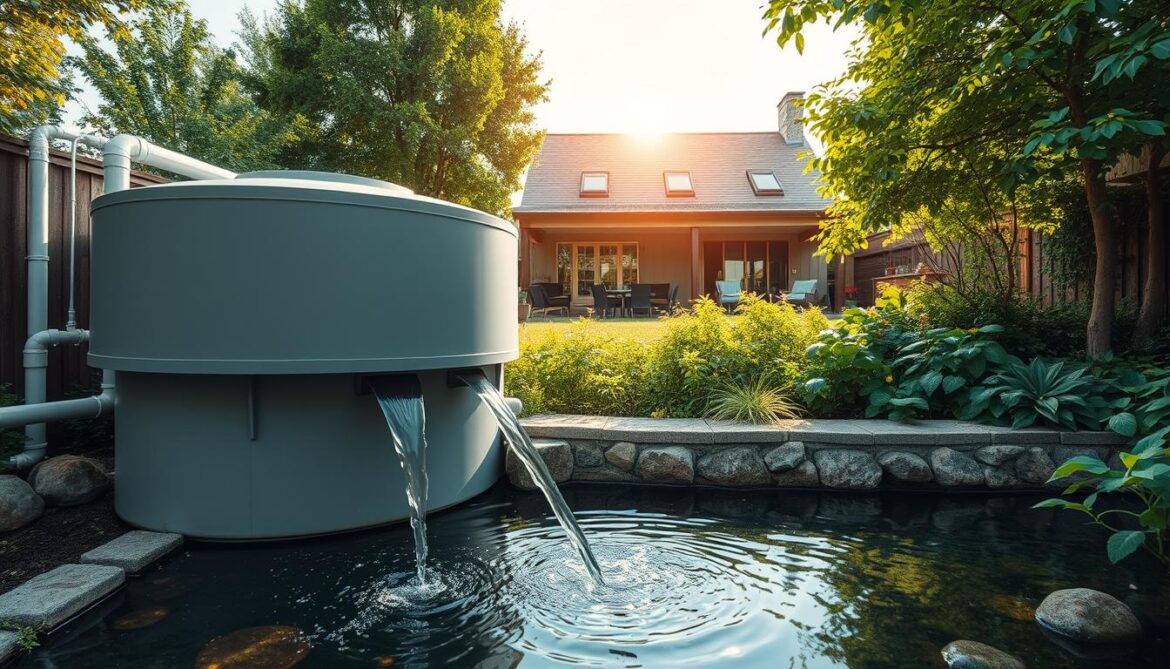


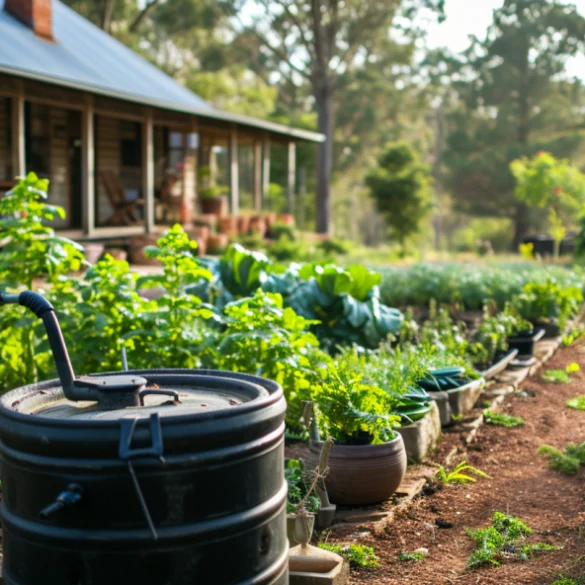
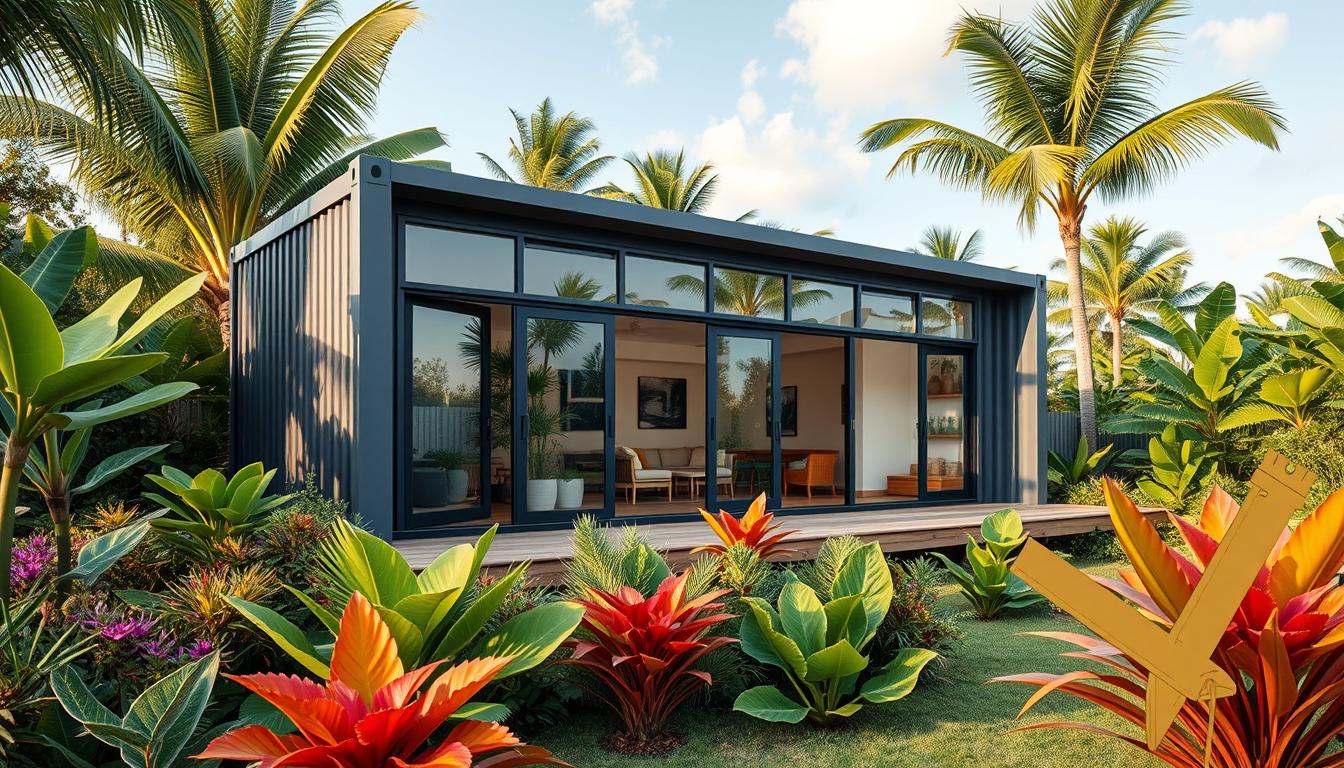



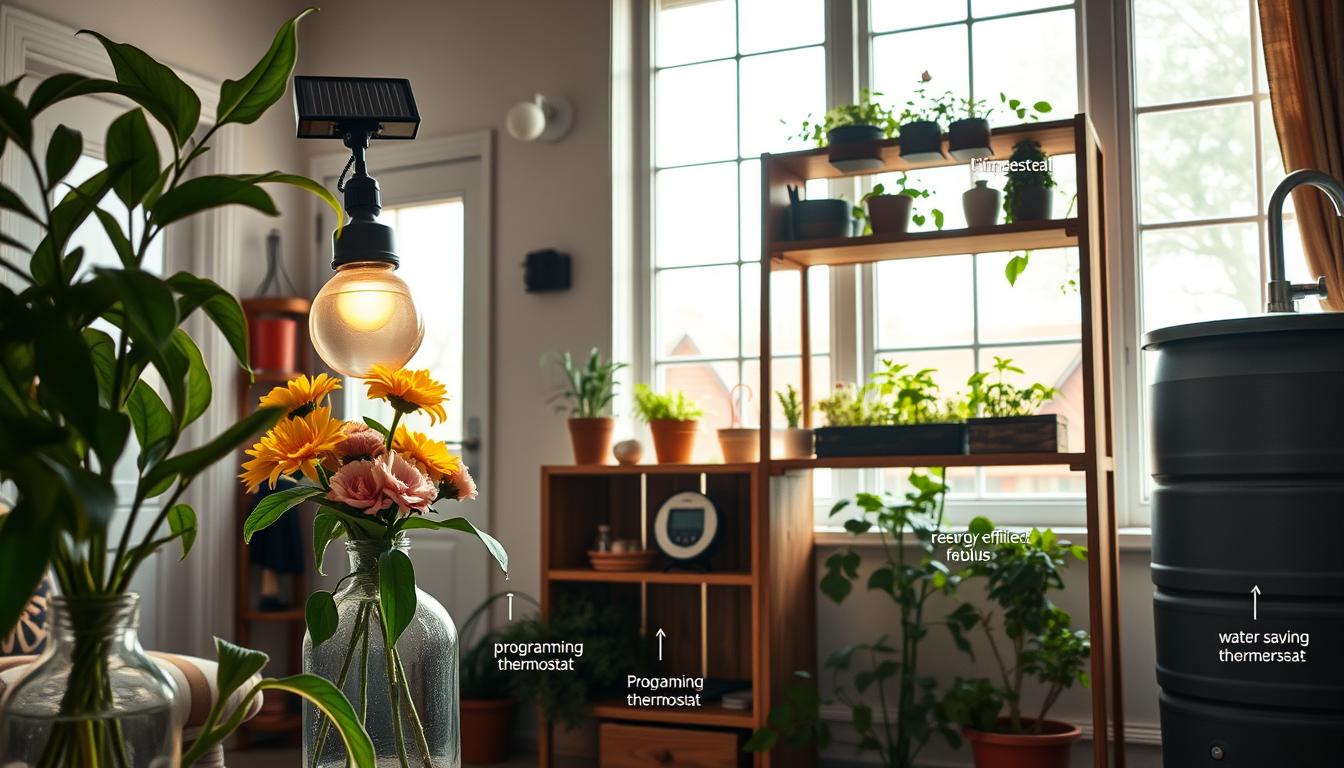
1 comment
[…] soaps that nourish soil instead of harming it. Check local codes—most states allow basic greywater systems without permits if you follow safety […]